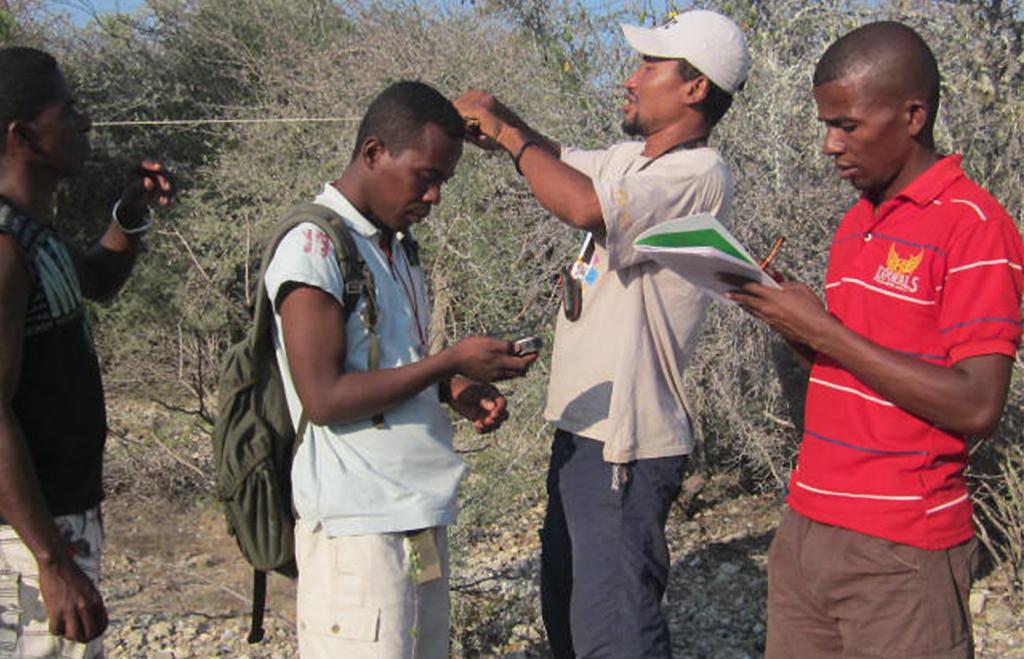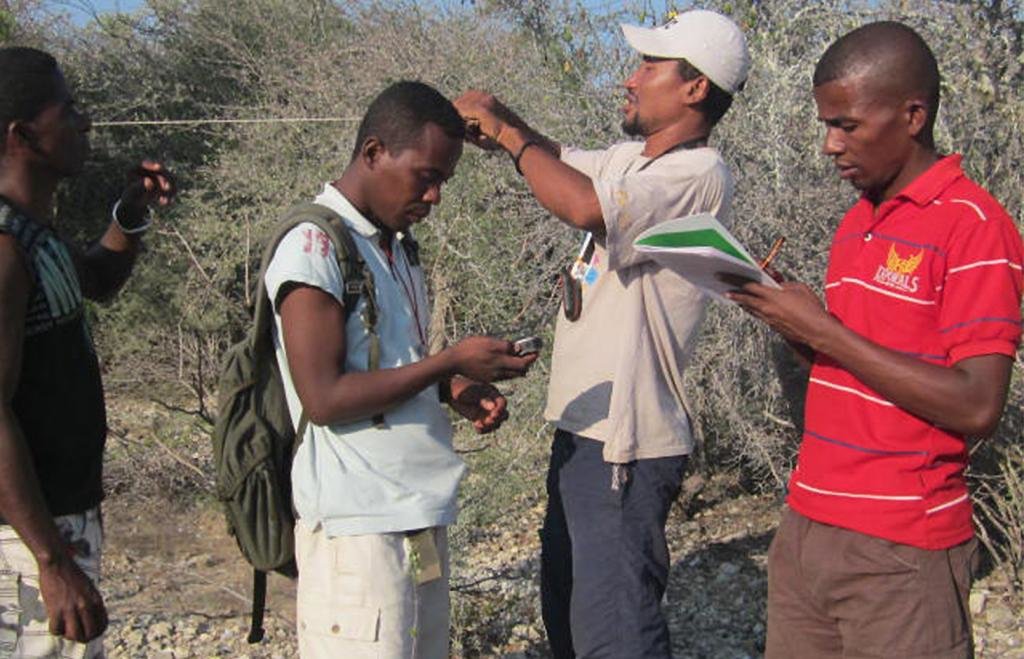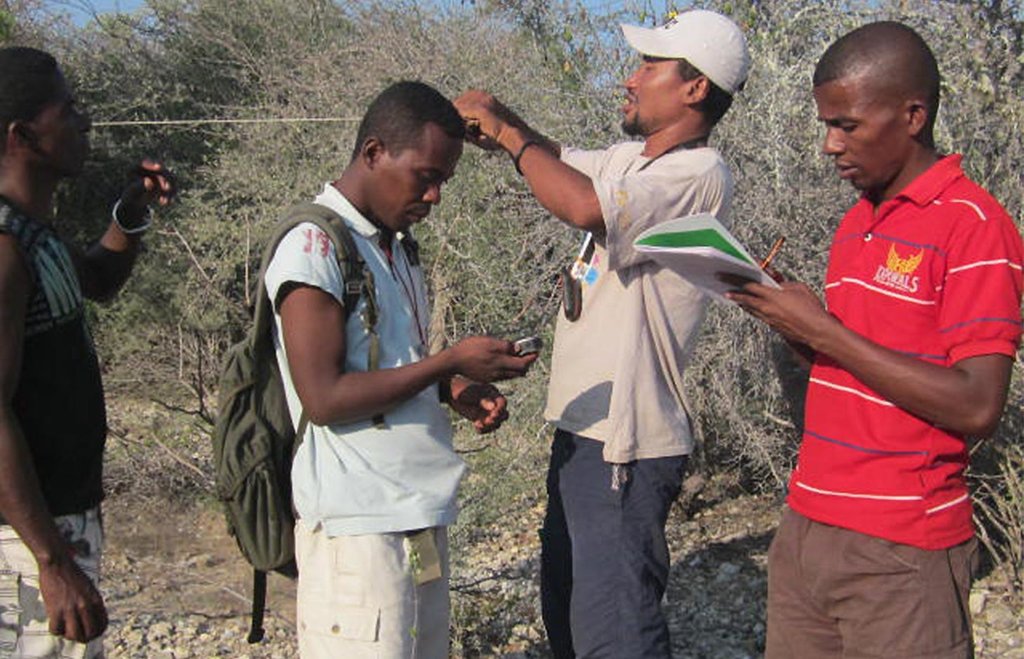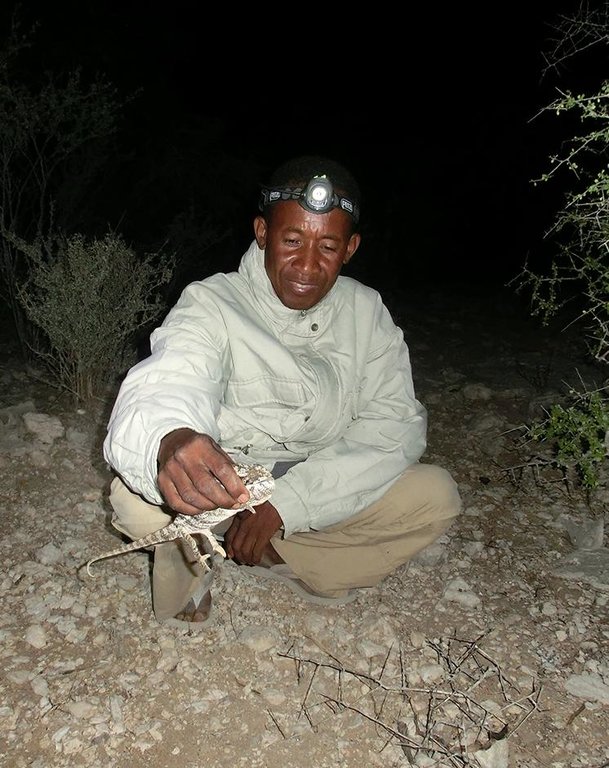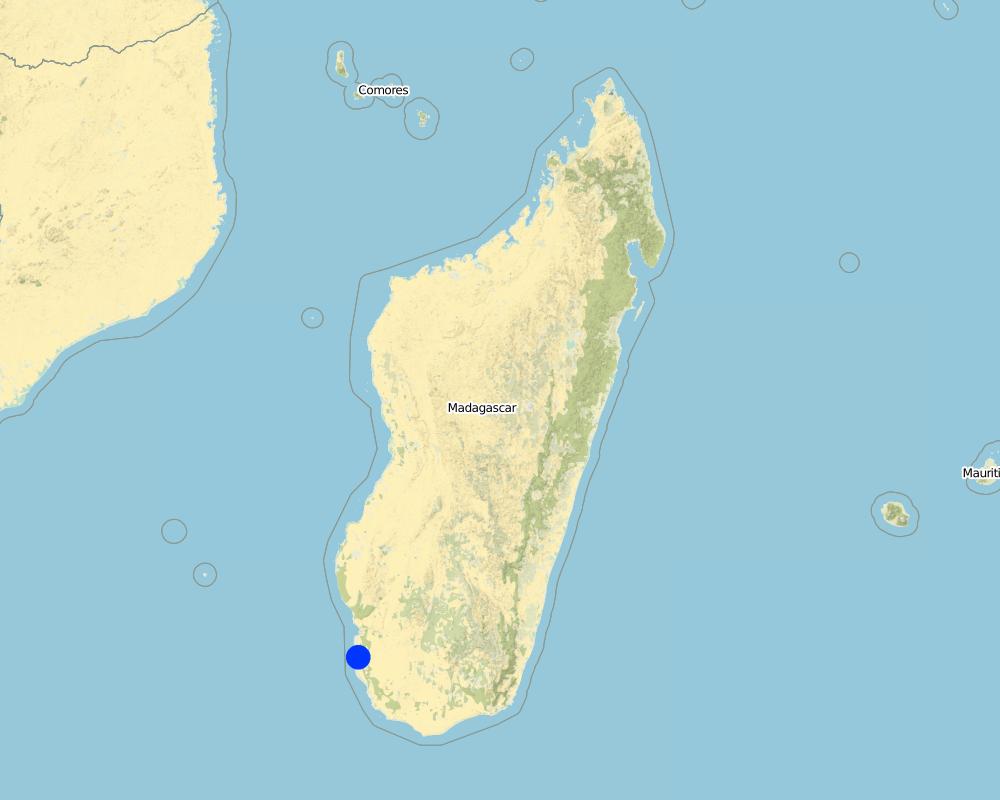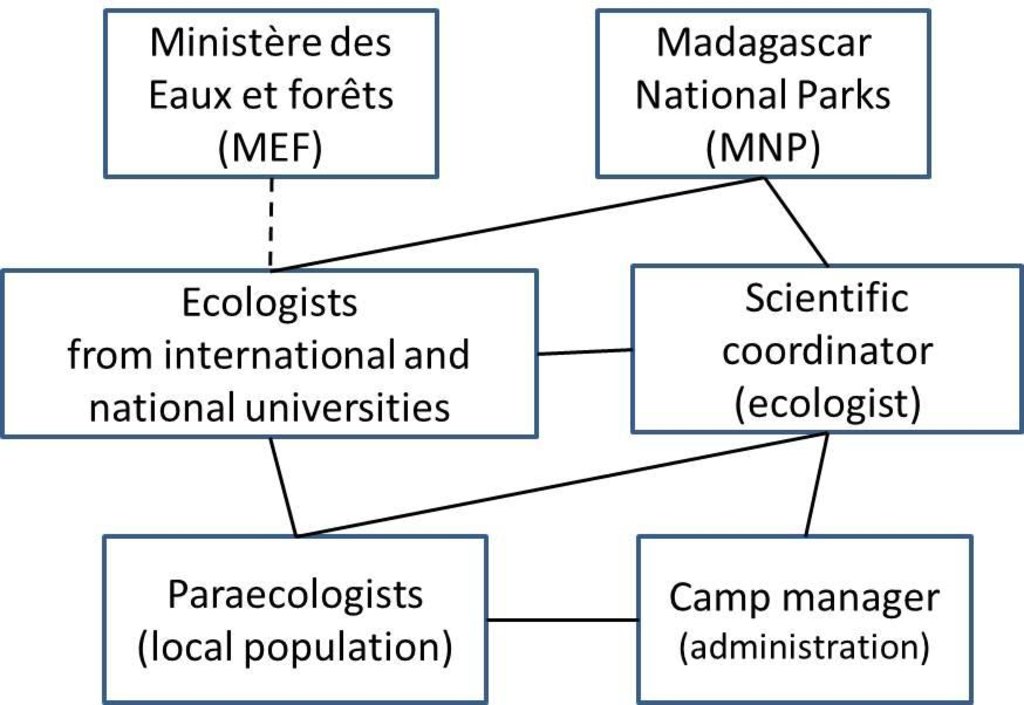Participatory monitoring and evaluation of long-term changes in ecosystems [Madagascar]
- Criação:
- Atualização:
- Compilador/a: Joachim Nopper
- Editor: –
- Revisores: Fabian Ottiger, Deborah Niggli
approaches_2610 - Madagascar
Veja as seções
Expandir tudo Recolher tudo1. Informação geral
1.2 Detalhes do contato das pessoas capacitadas e instituições envolvidas na avaliação e documentação da abordagem
Especialista em GST:
Ratovonamana Yedidya R.
Université d'Antananarivo
Madagascar
Especialista em GST:
Ganzhorn Jörg U.
Universität Hamburg
Alemanha
Nome do projeto que facilitou a documentação/avaliação da Abordagem (se relevante)
Sustainable Landmanagement in south-western Madagascar (SuLaMa / GLUES)Nome do projeto que facilitou a documentação/avaliação da Abordagem (se relevante)
Book project: Making sense of research for sustainable land management (GLUES)Nome da(s) instituição(ões) que facilitou(ram) a documentação/avaliação da Abordagem (se relevante)
Universität Hamburg (UHH) - AlemanhaNome da(s) instituição(ões) que facilitou(ram) a documentação/avaliação da Abordagem (se relevante)
University of Antananarivo - Madagascar1.3 Condições em relação ao uso da informação documentada através de WOCAT
Quando os dados foram compilados (no campo)?
11/04/2016
O/a compilador/a e a(s) pessoa(s) capacitada(s) aceitam as condições relativas ao uso de dados documentados através da WOCAT:
Sim
2. Descrição da abordagem de GST
2.1 Descrição curta da abordagem
Establishing a knowledge base and communication platform in collaboration with para-ecologists for monitoring changes in ecosystems, to aid decision-making in forest management.
2.2 Descrição detalhada da abordagem
Descrição detalhada da abordagem:
Aims / objectives: This approach strengthens knowledge about the response of biodiversity to environmental changes – namely land conversion, climate change induced impacts and climate-related extreme events, such as droughts and cyclones. Information generated can be used to inform regional authorities. They are then able to adapt management to current conditions, in order to better preserve biodiversity within the National Park. An important component of this approach is the integration of people from the local population as 'para-ecologists' who are trained in survey techniques for biodiversity monitoring. They directly observe changes in biodiversity, and share their knowledge with others in the area. The approach, thus, includes the sensitization of the local population to impacts of environmental change on biodiversity.
Methods: Under this approach, local assistants were trained in biodiversity monitoring techniques by researchers during their regular research activities. Part of the process comprised skills in species identification. Because the researchers had a limited period available for field work, training of these para-ecologists was a pre-requisite for implementation of long-term monitoring activities based on surveying at regular intervals. The surveys initiated by the researchers were plant phenology monitoring, regular capture, marking and recapture of Galidictis grandidieri (the giant striped mongoose) which is a flagship species in the Tsimanampesotse National Park, as well as reptile occurrence monitoring along transects. Monitoring procedures were established, and then continued by para-ecologists under the guidance of a Malagasy researcher who is familiar with ecological field work and acted as a ‘scientific coordinator’. The task of the scientific coordinator was data control and storage, planning of monitoring activities, as well as communication between national authorities, ecologists and para-ecologists. All survey data are available for scientific purposes and can be used to inform Malagasy authorities, or can be directly demanded by Malagasy authorities.
Stages of implementation: A basic research camp for monitoring was established within the Tsimanampesotse National Park in collaboration with Madagascar National Parks and WWF Toliara with third party funding. Four para-ecologists, two cooks and a guard constitute the team. The camp is maintained by a manager who is responsible for maintenance of buildings and electric facilities as well as provision of food. Surveying equipment is stored at the base camp. Computers and other necessary equipment were provided under the SuLaMa project. There are two para-ecologists trained on flora and a further two on fauna. Survey sites for monitoring of animal diversity and plant phenology were established by plant and animal ecologists in cooperation with the para-ecologists. Infrastructure for data acquisition and storage was established. This included the installation of electrical facilities as well as the provisioning of field books and computers. Technicians received language courses and learned computer operation. Regular exchange between the research camp and the national park authority, MNP, was established through a permanently employed scientific coordinator. This exercise resulted in a first workshop on survey techniques, in which staff of Madagascar National Park learned from researchers and para-ecologists.
Role of stakeholders: All survey data are available for scientific purposes and can be used to inform Malagasy authorities, or can be directly demanded from Malagasy authorities.
2.3 Fotos da abordagem
2.5 País/região/locais onde a abordagem foi aplicada
País:
Madagascar
Região/Estado/Província:
Atsimo-Andrefana (South-West Madagascar)
Especificação adicional de localização:
Beheloke
Map
×2.6 Datas de início e término da abordagem
Indique o ano de início:
2011
Ano de término (caso a abordagem não seja mais aplicada):
2016
2.7 Tipo de abordagem
- Baseado em projeto/programa
2.8 Principais metas/objetivos da abordagem
The Approach focused mainly on SLM with other activities (raising environmental awareness, environmental education)
Collect data on biodiversity to increase understanding of environmental change impacts. Use of this data to inform conservation managers. Involve the local population in this process to raise awareness and create ownership.
The SLM Approach addressed the following problems: Lack of knowledge about the changes in biodiversity within the national park; inadequate expertise in animal and plant identification; lack of knowledge about standardized sampling methods; data storage and dissemination not established.
2.9 Condição que propiciam ou inibem a implementação de tecnologia/tecnologias aplicada(s) segundo a abordagem
Normas e valores sociais/culturais/religiosos
- Inibitivo
language barrier
Treatment through the SLM Approach: employment of a French teacher
Conhecimento sobre GST, acesso a suporte técnico
- Inibitivo
No housing and facilities for para-ecologists, no infrastructure for data entry and storage as well as storage of equipment
Treatment through the SLM Approach: Establishment of a research camp as the base for all monitoring activities; Establishment of a database for storage of survey data. Keeping of a copy by the scientific coordinator who is able to distribute the data to researchers.
Carga de trabalho, disponibilidade de força de trabalho
- Inibitivo
Due to different reasons surveys were occasionally cancelled.
Treatment through the SLM Approach: Data quality of monitoring programs suffers if
surveys are not conducted at regular intervals. To avoid the cancellation of surveys, two persons were trained in the same survey techniques, so that a replacement is available. Nevertheless, occasional cancellations could not be avoided.
3. Participação e papel das partes interessadas envolvidas
3.1 Partes interessadas envolvidas na abordagem e seus papéis
- Usuários de terra/comunidades locais
members of local population that gain knowledge on biodiversity
- Pesquisadores
Para-ecologists are all men. Camp staff are equally divided between women and men. No woman occupied a top position however.
- Organização não governamental
MNP, WWF
- Governo nacional (planejadores, responsáveis pelas decisões)
MEEF
access to monitoring data and knowledge on status of biodiversity conservation effectiveness.
- Organização internacional
BMBF
Caso várias partes interessadas foram envolvidas, indique a agência líder:
Researchers from different disciplines were involved. Scientific coordination was conducted by a Malagasy botanist.
3.2 Envolvimento do usuários de terra/comunidades locais nas diferentes fases da abordagem
| Envolvimento do usuários de terra/comunidades locais | Especifique quem estava envolvido e descreva as atividades | |
|---|---|---|
| Iniciação/motivação | Apoio externo | Training, identification of places for monitoring activities |
| Planejamento | Nenhum | |
| Implementação | Apoio externo | Monitoring within the National Park, giving results of research to National Park staff |
| Monitoramento/avaliação | Nenhum | |
| Research | Nenhum |
3.3 Fluxograma (se disponível)
Descrição:
Key partners for a biodiversity monitoring programme in southwestern
Madagascar. Collaborative research is focussed in and around Tsimanampesotse National Park. Ecologists train para-ecologists and develop long term monitoring programs. Scientific coordinator collects data and communicates results to MNP. Para-ecologists conduct surveys, a camp manager ensures research equipment is available and coordinates maintenance.
3.4 Decisão sobre a seleção de tecnologia/tecnologias de GST
Foram tomadas decisões quanto à seleção de tecnologia(s):
- by researchers
Explique:
Decisions on the method of implementing the SLM Technology were made by by reasearchers. n/a
4. Suporte técnico, reforço das capacidades e gestão do conhecimento
4.1 Reforço das capacidades/ formação
Foi oferecida formação aos usuários da terra/outras partes interessadas?
Sim
- local population
Assuntos abordados:
Local men who were trained in animal and plant identification and survey techniques. They became specialists in their area of work and due to regular surveys, better understand the effects of environmental changes on plant phenology and the occurrence and behaviour of animals. They share their knowledge in their villages, thus contributing to raising awareness about the environment.
4.2 Serviço de consultoria
Os usuários de terra têm acesso a um serviço de consultoria?
Sim
Descreva/comentários:
Advisory service is inadequate to ensure the continuation of land conservation activities
4.3 Fortalecimento da instituição (desenvolvimento organizacional)
As instituições foram fortalecidas ou estabelecidas através da abordagem?
- Não
4.4 Monitoramento e avaliação
Monitoramento e avaliação são partes da abordagem?
Sim
Comentários:
technical aspects were ad hoc monitored by government through observations; indicators: data collection by paraecologists was observed by researchers during training phase
Control of data quality aspects were ad hoc monitored by project staff through observations
Regular data collection aspects were regular monitored by project staff through
There were no changes in the Approach as a result of monitoring and evaluation
There were no changes in the Technology as a result of monitoring and evaluation: n/a
4.5 Pesquisa
A pesquisa foi parte da abordagem?
Sim
Especifique os tópicos:
- Ecologia
Dê mais detalhes e indique quem realizou a pesquisa:
Research was exclusively undertaken within the national park. Extension of research activities into non-protected areas is aspired in collaboration with the local communities.
Research was carried out on station
5. Financiamento e apoio material externo
5.1 Orçamento anual para o componente de GST da abordagem
Caso o orçamento exato seja desconhecido, indique a faixa:
- 10.000-100.000
Comentários (p. ex. principais fontes de recursos/principais doadores):
Approach costs were met by the following donors: international (German Ministry of Education and Research, BMBF): 100.0%
5.2 Apoio financeiro/material concedido aos usuários da terra
Os usuários da terra receberam apoio financeiro/material para a implementação de tecnologia/tecnologias?
Sim
5.3 Subsídios para entradas específicas (incluindo mão-de-obra)
- Equipamento
| Especifique quais entradas foram subsidiadas | Em que medida | Especifique os subsídios |
|---|---|---|
| electric facilities and research equipment | Totalmente financiado | |
- Construção
| Especifique quais entradas foram subsidiadas | Em que medida | Especifique os subsídios |
|---|---|---|
| construction & maintenance of research camp | Totalmente financiado | |
- Infraestrutura
| Especifique quais entradas foram subsidiadas | Em que medida | Especifique os subsídios |
|---|---|---|
| cart | Totalmente financiado | |
Se a mão-de-obra pelos usuários da terra foi uma entrada substancial, isso foi:
- Pago em dinheiro
Comentários:
Monthly salary for para-ecologists, as well as staff of research camp.
Research equipment included among others Computers, torches, GPS units, cameras. A cart was needed to transport persons and material.
5.4 Crédito
Foi concedido crédito segundo a abordagem para atividades de GST?
Não
6. Análise de impactos e declarações finais
6.1 Impactos da abordagem
A abordagem auxiliou os usuários da terra a implementar e manter as tecnologias de GST?
- Não
- Sim, pouco
- Sim, moderadamente
- Sim, significativamente
This approach is to evaluate long-term impacts of land conversions, gradual climate change and climate-related extremes (disasters) on biodiversity. Due to insufficient data because of the short time since implementation, impacts have not yet been assessed.
A abordagem concedeu autonomia aos grupos social e economicamente desfavorecidos?
- Não
- Sim, pouco
- Sim, moderadamente
- Sim, significativamente
By providing employment for some local people.
Did other land users / projects adopt the Approach?
- Não
- Sim, pouco
- Sim, moderadamente
- Sim, significativamente
Community-based monitoring is on the rise in Madagascar.
Did the Approach lead to improved livelihoods / human well-being?
- Não
- Sim, pouco
- Sim, moderadamente
- Sim, significativamente
Para-ecologist and associated staff of the research camp were continuously employed; a job opportunity that is rarely encountered within the study region. Awareness of the value of biodiversity has been raised.
Did the Approach help to alleviate poverty?
- Não
- Sim, pouco
- Sim, moderadamente
- Sim, significativamente
By providing employment for some local people.
6.2 Principal motivação dos usuários da terra para implementar a GST
- Pagamentos/subsídios
employment
- well-being and livelihoods improvement
regular salaries
6.3 Atividades de sustentabilidade de abordagem
Os usuários da terra podem manter o que foi implementado através da abordagem (sem apoio externo)?
- Não
Caso negativo ou incerto, especifique e comente:
Data collection by members of the local population is only valuable if data are subsequently quality-assured, analysed and evaluated. Thus without support from researchers this approach is of no value.
6.4 Pontos fortes/vantagens da abordagem
| Pontos fortes/vantagens/oportunidades na visão do/a compilador/a ou de outra pessoa capacitada |
|---|
| By employing people from villages surrounding the national Park in regular research activities as well as biodiversity monitoring, knowledge on dynamics of natural systems is experienced firsthand and can be transmitted to other members of the local population. This can be seen as an informal knowledge hub from which communities learn more about the ecosystem they live in. (How to sustain/ enhance this strength: Creating owenership might lead to a more sustainable resource use practice.) |
| Collecting data and knowledge to support evidence based decision making for biodiversity conservation (How to sustain/ enhance this strength: Maintain and carry forward the knowledge base and communication platform by ensuring funding ) |
6.5 Pontos fracos, desvantagens da tecnologia e formas de superá-los
| Pontos fracos/vantagens/riscos na visão do/a compilador/a ou de outra pessoa capacitada | Como eles podem ser superados? |
|---|---|
| Monitoring activities depend on continuous funding. Funding was provided by SuLaMa/BMBF. Efforts for a continuation of funding need to be undertaken throughout project implementation as well as after project has terminated. | The situation could be stabilized by mainstreaming monitoring activities in programs of in-country authorities, which is planned but has not yet been implemented. |
7. Referências e links
7.1 Métodos/fontes de informação
- visitas de campo, pesquisas de campo
- entrevistas com usuários de terras
Links e módulos
Expandir tudo Recolher tudoLinks
Não há links
Módulos
Não há módulos


